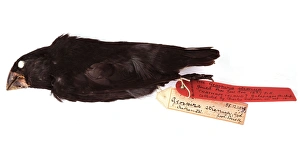Geospiza Collection (#2)
Geospiza, a genus of finches found in the Galapagos Islands, showcases remarkable adaptations and behaviors
All Professionally Made to Order for Quick Shipping
Geospiza, a genus of finches found in the Galapagos Islands, showcases remarkable adaptations and behaviors. The Geospiza magnirostris, also known as the large ground finch, possesses a robust beak that allows it to crack open tough seeds. Similarly, the Geospiza conirostris, or large cactus finch, has developed a specialized beak for extracting nectar from cactus flowers. On the other hand, the Geospiza fuliginosa represents small ground finches with different variations. These tiny birds demonstrate diverse feeding habits; some feed on insects while others rely on plant matter like wild seeds and native tomatoes, and is fascinating to observe how these species have adapted their beaks according to their preferred food sources. One intriguing behavior observed among these finches is seen in Darwin's cactus finch (Geospiza scandens), which feeds on Opuntia cactus flower. Another peculiar example is the vampire ground finch (Geospiza septentrionalis) attacking larger chicks to drink their blood—a unique adaptation rarely seen in birds. The symbiotic relationship between certain species within this genus is also noteworthy. For instance, Darwin's small ground finch (Geospiza fuliginosa) can often be spotted cleaning ticks off Alcedo giant tortoises (Chelonoidis vandenburghi). This mutualistic interaction benefits both parties involved. Moreover, these resourceful birds are not limited by their surroundings when it comes to finding sustenance. Darwin's medium ground finch (Geospiza fortis) skillfully feeds on wild seeds and even indulges in saltbush alongside its smaller counterpart—the female small ground Finch (Geospiza fuliginosa). Geospiza exemplifies incredible adaptability and diversity within its various species of ground and cactus-finches inhabiting the Galapagos Islands. Their distinct characteristics and behaviors offer a glimpse into the fascinating world of avian evolution.



